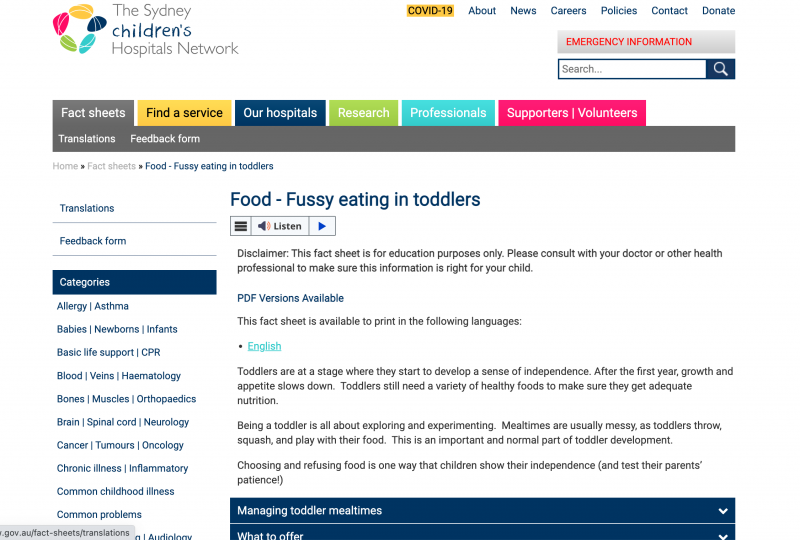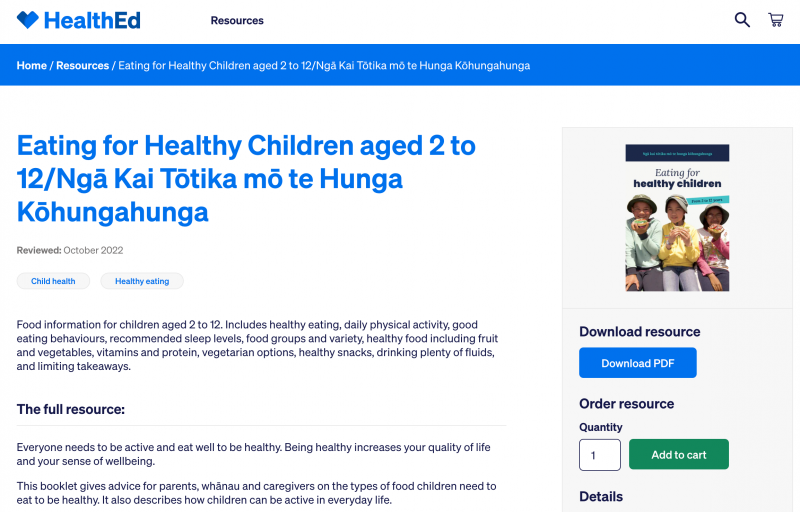Fussy Eating In Children
Fussy Eating In Children
Fussy eating is common in tamariki (children), and it's common for them to dislike certain foods. Tamariki will gradually eat and explore new foods as they get older. Providing healthy food and an enjoyable eating environment for your child will help them enjoy mealtimes.
Key points about fussy eating in children
- fussy eating is common in tamariki - most tamariki will eat when they’re hungry
- it is common for tamariki to dislike some foods
- most tamariki gradually eat and explore new foods as they get older
- it can be useful to let tamariki choose from a range of different healthy foods
- low-stress regular mealtimes can help with fussy eating behaviours
- getting your child involved in preparing and making food can help with fussy eating
- if your tamariki is growing and has enough energy to play, learn and explore, they’re probably eating enough
- if your child loses weight or stops gaining weight, see your family doctor as soon as possible
About fussy eating in children
Fussy eating is common in tamariki, and it's common for them to dislike certain foods. Children's appetites change as they grow and develop. For young children aged 1 to 6 years, their eating habits can change from day to day. Things like being tired may make them less interested in eating.
It's important to remember tamariki often prefer different tastes to adults. They are often too busy exploring the world around them to spend time eating.
What causes fussy eating in children?
Part of the way tamariki learn is by testing their boundaries. They may show strong-willed behaviours towards eating, such as whether to eat or not eat or when choosing what to eat. This is a normal part of their development.
Children’s appetites can go up and down for a number of reasons, such as:
- how active they are
- how much they're growing
- how they're feeling; for example, how tired they are
What to do if my child is a fussy eater?
If your child is a fussy eater, making mealtimes pleasant can make them more willing to try foods. Having healthy food options for your whānau and an enjoyable eating environment will help your child enjoy mealtimes.
Check some tips for creating low-stress mealtimes.
Remove distractions and set a time limit on mealtimes
Remove distractions, turn off televisions and screens so you can focus on your meal. Set a time limit on your meals, as it can be stressful if it drags on. If your child hasn't eaten the food during that time, take it away without fuss. We eat the most in the first 10 minutes of a meal, so aim to finish the meal within 20 to 30 minutes.
Try to stay calm
Never force your child to try a food. If your child is fussing, try to remain calm so mealtimes feel relaxed and enjoyable. Try not to worry about any mess that's being made. It can take a child 10 to 15 times for a new food to be offered before they will accept it. Don't assume your child doesn't like a particular food after a few attempts, stay calm and offer the food again another time.
Let tamariki eat to their appetite
Offer your child 3 meals and 2 to 3 snacks per day. Tamariki need a gap of at least 2 hours without eating before they will feel hungry again. If your child doesn’t eat at every opportunity you provide, that's OK. A child's appetite can vary from day to day. Try to avoid your child filling up on drinks, offer drinks halfway through and at the end of a meal instead.
Provide a range of healthy food
Start with small amounts of food on your child's plate. Offer a range of nutritious foods from all the food groups at each meal. The 4 main food groups are:
- fruit and vegetables
- grains such as rice, pasta, cereal and bread
- milk and milk products, including calcium-enriched plant-based milks such as almond milk
- meat, chicken, seafood, eggs, legumes, nuts and seeds
Make food fun
Make healthy food fun. Prepare food in a way your child can manage. You could try cutting sandwiches into fun shapes or use fruit and vegetables to make a funny face on the plate - eyes, a mouth and a nose. Include a variety of colours, shapes and textures - a cookie cutter helps make fun shapes.
Lead by example
If the whānau is eating a range of different healthy foods, it shows your child that everyone is willing to try new foods and enjoy them.
Keep treat food for special occasions
It can be tempting to offer your child treat foods when they won't eat something. Or you may use it as a way to get them to eat something healthy first. But this can make your child more interested in the treat food. You could try to use rewards that aren’t food based such as an extra bedtime story, if you want to praise your child for their positive eating habits. It can help to praise your child for at least one thing they do at every meal. This could be good chewing or biting, good sitting, good food exploring, and so on.
Try to make mealtimes regular and social
Make mealtimes regular, social occasions. Look for opportunities for your child to share meals and snacks with others. They might be more willing to try a food if they see others eating it.
Take a look at this video by KidsHealth for more reasons why shared meal times are great for the whole family.
Should I encourage my child to be more independent with food?
Supporting your child to be independent with food can help with fussy eating. Food independence is when you let your child decide how much and what they will eat. You provide healthy food options for your child. It's best to limit their options to 2 to 3 different foods so they don't get overwhelmed.
Another way to encourage food independence is to involve your child in preparing meals. Young people are more likely to eat something if they have been involved in making it. You could let them try things like:
- picking a recipe
- washing fruits and vegetables
- getting food out of the fridge and pantry
- setting the table for a meal
- planting and picking herbs and vegetables at home
- mixing things together
Could this be more than fussy eating?
Most tamariki will gradually eat and explore new foods as they get older. It is common for tamariki to dislike certain foods. But, some tamariki with an eating disorder may show the following behaviours:
- a deep dislike toward food and eating
- fear of eating because of possible outcomes such as vomiting or choking
- no interest in food and eating
These could be signs of an underlying condition called avoidant restrictive food intake disorder (ARFID). Because tamariki with ARFID restrict the quantity and variety of food they eat, they can lose weight and become unwell. Tamariki with ARFID need a lot of support to try new foods and to eat enough food for good development.
If you are worried your child may have ARFID or your child's eating behaviours cause them to lose weight or stop gaining weight, see your family doctor as soon as possible.
Check out KidsHealth's page on ARFID for more information
When should I seek help?
If your child is healthy and has the energy to learn, play and explore, they are probably eating enough. But, if you have concerns, don't wait. If you are worried your child isn't eating enough or they only eat a small range of foods, see your family doctor as soon as possible.
Where do I get help for my child?
If you are finding mealtime really difficult with your child, reach out for support. Seeing your family doctor is a good starting point. Your doctor may arrange for you to receive extra support with your child's eating behaviours.
Resources and ideas for parents of fussy eaters
See the HealthEd webpage Eating for healthy children aged 2 to 12 | Ngā kai tōtika mō te hunga kōhungahunga which has some general advice on healthy eating for young people.
This page last reviewed 05 June 2023.
Do you have any feedback for KidsHealth?
If you have any feedback about the KidsHealth website, or have a suggestion for new content, please get in touch with us.
Email us now


